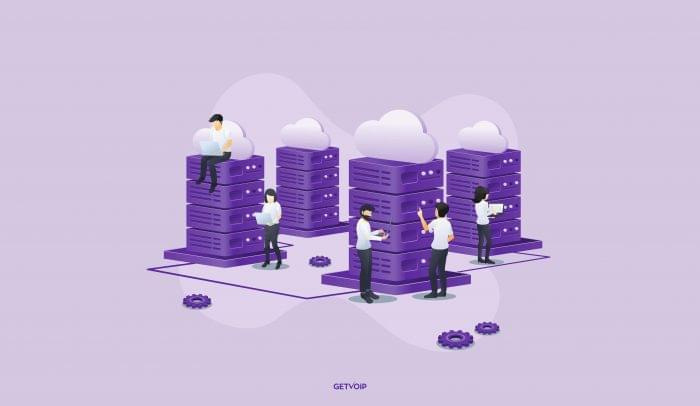How are your customers reaching you? Gone are the days when customers solely reached out to brands via voice channels like traditional PSTN landlines. These days, customer EXPECT brands to be reachable by a variety of channels, and an increasing number of companies are using enterprise VoIP solutions that add communications to their mobile applications.
Does this mean that the brand’s developers have to go back to the drawing board every time they want to add a communications channel to an app? Well, with communication APIs, development teams add these channels to existing mobile apps without massive development times.
66% of consumers use an average of more than three touch-points for contact with their favorite brands, so it will fall on your team to be agile enough to add these to your app profile.
What are Communication APIs?
A communication API is a type of application programming interface (API) that adds communications channels to particular software. What’s an API? Well, an API, in its most basic terms, is a piece of code that allows two pieces of software hosted on the cloud to connect to each other and transfer information. APIs deliver plugging power and save on development time. So, if you have a software solution, and you want to connect it to a CRM like Salesforce, then you’d need an API. According to Forrester, APIs allow you to deliver services that solve unique problems, and in many cases, APIs that focus on communication channels make interactions more convenient for the customer.
As a type of API, these connect your app to a particular service. For example, your app may have built-in voice connectivity so that your customers can reach your agents easily. Using an API of this type allows you to add SMS or MMS, video, social media, or even specialized channels like WhatsApp to your application on an as-needed basis. Other tools, like software development kits (SDKs), work as a means for your developers to create the specialized solutions that your business needs.
Types of APIs for Communication
Understanding how these APIs function is critical. Here are a few distinct types that you’ll inevitably have to incorporate into your application’s loadout:
Voice APIs
When incorporating this type of API, there are varied functions that your development team adds to make it easier for customers to reach your team. While it may seem obvious that voice calling by traditional phone numbers is the base functionality, your team also can add call recording, call routing, conference calling, and even text-to-speech functions to your application. REST APIs are also added so that the app both sends and receives phone calls. This type of API allows voice services to connect with one another.
SMS, MMS, and RCS APIs
More than 65% of the world’s population sends text messages, and more than two trillion texts were sent in 2018 alone, so you’ll want to leverage texting to reach customers. Most communication platform as a service (CPaaS) providers delivers texting features that will reach out via short message service (SMS) and multimedia message service (MMS), which are standard texting formats. Solutions like the Twilio Messaging API will convert SMS to MMS, allow for automatic picture resizing (to accommodate file size limitations), and allow for message tracking for reporting.
Thanks to a recent announcement by major carriers in 2019, rich communications services (RCS) messaging, which allows for more detailed messages with buttons, multimedia, and location information via apps like Google Maps, is appearing in many CPaaS API lists. The only limitation of this type of messaging API is that it currently only works for Google Android devices.
Chat APIs
It’s not all about text. Many customers prefer the experiences provided by Facebook Messenger and WhatsApp, so several providers have included these API extensions. Adding this functionality to your app presents your business with more than just text-based communication APIs with chat functions make it easy to send documents and files to customers. For example, when you need to send a monthly billing statement or receipt to your customers, it’s done easily using the right communications APIs for chat software.
Emergency Calling APIs
APIs from providers like Voxbone grant access to E911 services so that businesses can permit their end-users to contact local emergency services when needed. This is typically provided worldwide where the service exists, which grants users peace of mind when a disaster occurs.
Why These APIs are Needed

There was a time when adding communications features to apps took weeks, if not months of development time. With modern APIs and SDKs, development teams can add channels in half the time or less. This is because many providers grant access to pre-built API reference code that developers simply add to their applications to add on functionality. In fact, some providers try to reduce the amount of coding needed via unique UIs so that even non-tech-oriented people can enhance their applications.
As we stated in our State of the Call Center guide, 92% of organizations that view customer experience as a service differentiator offer multiple channels of contact, and solutions like these make this an overall easier process. For example, the standard interactive voice response is designed to help progress customers through a menu system and is even useful for achieving customer self-service. Effective simple APIs can be used to increase the self-service percentages for your customer experience by incorporating visual IVR or chatbots into the app that uses visual menus to help the customer.
CPaaS providers are making it very easy to add these communications channels, and the price involved is often very reasonable, especially compared to traditional development methodologies. As a result, smaller businesses with more meager development staff are able to create responsive applications that have omnichannel communications.
For example, by using these API platforms, a non-profit creates an application that gives updates about current drives and events. The nonprofit adds APIs to the application that allows the app to send visual IVR messages that walk supporters through the donation process. Implementing the changes to the app only takes a small development team a few days so that donations are able to come in as soon as the new push begins.
These are also amazing for customer satisfaction; when you’re engaging your customers on their favored communications platform, interactions are more pleasant. For example, in a rideshare app, a driver sends SMS or voice messages to the customer. This allows the customer to be able to update the driver and give fine-tuned directions on how to reach the pickup location. Adding SMS APIs and voice to an application on either Android or iOS is very simple, and development teams will need to know nothing of telecom to deliver these communication channels.
Do Webhooks Streamline Business Processes?

When standard and web APIs connect two applications or services, they do so by polling. The API sends out a request from one side and waits for the other side of the communication event to respond. This is done at a preset frequency, and it’s done every time your API attempts a connection.
Webhooks are slightly different from APIs for communication because they don’t poll. Instead of sending out a request and waiting for confirmation to come back, webhooks establish endpoint URLs that are used for future connection requests. Virtually, these cut out a step and are more efficient. The app information is updated in real-time, and webhooks are also easier to maintain on the development side of things.
You Need APIs for Better Customer Experiences
Simply put, you can’t afford to only leverage voice communications – you need to open up to omnichannel outreach. Communications APIs make this very easy, even with smaller development teams. Added communication channels bring convenience for your customers and provide additional inroads for following up with leads, which results in better profits. This is particularly valuable during the era of COVID-19, which necessitates that companies rely on remote ways to contact customers.
Looking to expand your communications so that you can better reach your customers? Check out our guides on CPaaS providers. Use our breakdowns to find out information about multiple solutions, and you’ll even be able to get an idea about pricing models.



